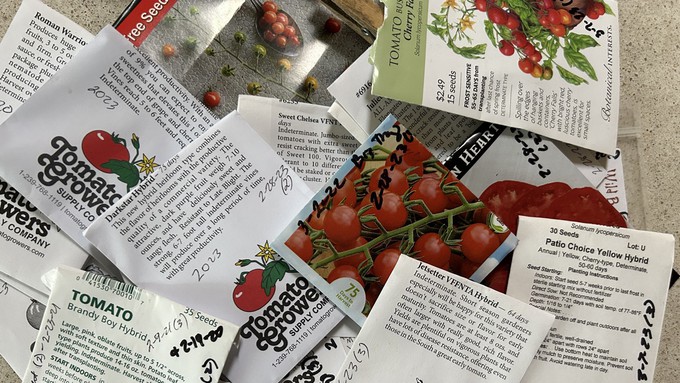
Placer County master gardeners host free in-person workshop

Hmm, there's bound to be seeds to swap in this collection. Learn about seed saving and sharing during a Placer County master gardener-led workshop Jan. 13. Kathy Morrison
What does a gardener do on a cold, damp January day? It’s a good time to sort seeds (before ordering new packets).
You also may want to swap some extra seeds with gardening friends – or get ready to save seeds for future growing seasons.
Learn all about saving and sharing seeds during an upcoming free workshop. Hosted by the UCCE master gardeners of Placer County, “Seed Saving Flowers and Vegetables” will be held at 10:30 a.m. Saturday, Jan. 13, at the Loomis Library. No advance registration is necessary.
“Did you know that National Seed Swap Day is January 27, 2024?” say the organizers. “Honor the great U.S. tradition of swapping seeds with neighbors and sharing warmth with your community. You will learn the basics rules for seed saving, germination requirements by species, how to grow plants identical to the parent plant and how to preserve heirlooms.”
Not only will you be saving seeds, but saving money, too: Growing vegetables and flowers from seed costs a fraction of buying transplants. The one-hour class will cover all the basics to get you started.
Loomis Library is located at 6050 Library Drive in Loomis.
Details and directions: https://pcmg.ucanr.edu/.
Comments
0 comments have been posted.Sacramento Digs Gardening to your inbox.
Sites We Like
Garden Checklist for week of Nov. 3
November still offers good weather for fall planting:
* If you haven't already, it's time to clean up the remains of summer. Pull faded annuals and vegetables. Prune dead or broken branches from trees.
* Now is the best time to plant most trees and shrubs. This gives them plenty of time for root development before spring growth. They also benefit from fall and winter rains.
* Set out cool-weather annuals such as pansies and snapdragons.
* Lettuce, cabbage and broccoli also can be planted now.
* Plant garlic and onions.
* Keep planting bulbs to spread out your spring bloom. Some possible suggestions: daffodils, crocuses, hyacinths, tulips, anemones and scillas.
* This is also a good time to seed wildflowers and plant such spring bloomers as sweet pea, sweet alyssum and bachelor buttons.
* Rake and compost leaves, but dispose of any diseased plant material. For example, if peach and nectarine trees showed signs of leaf curl this year, clean up under trees and dispose of those leaves instead of composting.
* Save dry stalks and seedpods from poppies and coneflowers for fall bouquets and holiday decorating.
* For holiday blooms indoors, plant paperwhite narcissus bulbs now. Fill a shallow bowl or dish with 2 inches of rocks or pebbles. Place bulbs in the dish with the root end nestled in the rocks. Add water until it just touches the bottom of the bulbs. Place the dish in a sunny window. Add water as needed.
* Give your azaleas, gardenias and camellias a boost with chelated iron.
* For larger blooms, pinch off some camellia buds.
* Prune non-flowering trees and shrubs while dormant.
* To help prevent leaf curl, apply a copper fungicide spray to peach and nectarine trees after they lose their leaves this month. Leaf curl, which shows up in the spring, is caused by a fungus that winters as spores on the limbs and around the tree in fallen leaves. Sprays are most effective now.